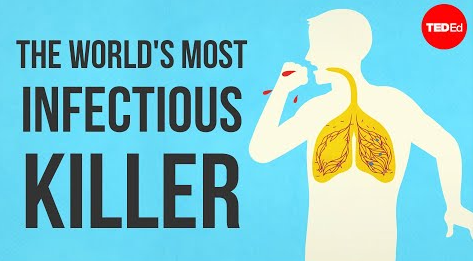In 2008, archeologists uncovered two 9,000-year old skeletons.
2008年,考古学家发现了两具9000年前的骸骨。
There's no definitive way of knowing what killed these ancient people, but we do know their bones were infected by an all too familiar bacterium.
这些古人的死因虽然尚未知晓,但感染这些骸骨的病菌我们再熟悉不过了。
The ancient Greeks knew its consumptive effects as phthisis; the Incans called it chaky oncay; and the English called it tuberculosis.
古希腊人将这一肺病称为“痨”;印加人将其称为“痨瘵” ,英国人称之为“肺结核”。
Today, tuberculosis, or TB, is still one of the world's biggest infectious killers, causing more deaths than malaria or even HIV and AIDS.
肺结核,或TB,如今仍是世界上最大的致命性感染病之一,导致死亡的人数超过疟疾或HIV病毒和艾滋病。
But what exactly is this disease, and how has this pathogen persisted for so long?
但这到底是何种疾病?这一病原体又为何如此难缠?
Typically, TB bacteria called mycobacterium tuberculosis, are airborne.
导致肺结核的结核杆菌一般是由空气传播的。
They travel into our airways and infect our lungs.
它们会进入气管并感染肺脏。
Here, immune cells called macrophages rush to the infection site, attempting to absorb and break down the bacterial invaders.
肺里的巨噬细胞会赶到受感染处做出免疫反应,努力吞噬、分解这些细菌侵略者。
In many cases, this response is enough to remove the bacteria.
多数情况下这样就能消灭细菌。
But in individuals with other medical conditions -- ranging from malnutrition and HIV to diabetes and pregnancy
但患有其它病症的人,如营养不良,患有HIV、肥胖症或是怀有身孕,
the immune response may not be strong enough to destroy the intruder.
免疫系统则可能无法有效地消灭这些病菌。
If so, mycobacterium tuberculosis will reproduce inside those macrophages, and form colonies in the surrounding lung tissue.
这时结核杆菌会在巨噬细胞内繁殖,并在周边组织中形成菌落。
As they infect more cells, the bacteria employ cell-degrading enzymes that destroy the infected tissue, triggering chest pain, and causing patients to cough up blood.
受感染细胞不断增多,同时病菌会分泌酶素降解细胞并破坏受感染的组织,这会带来胸痛,使病人咳血。
The damage to the lungs leads to oxygen deprivation.
肺部受损会导致缺氧。
This begins a flood of hormonal changes -- including a decrease in appetite and iron production.
这会打乱荷尔蒙平衡,因此胃口会变差,铁元素的生成会降低。
From here, microbes can spread to the skeletal system, causing back pain and difficulty moving;
然后细菌会扩散到骨骼系统,带来背部疼痛、行动不便,
to the kidneys and intestines, causing abdominal pain; and to the brain, causing headaches and even impaired consciousness.
或扩散到肾脏和肠道,带来腹痛;或扩散到大脑,导致头疼甚至神智不清。
These symptoms produce the classic image of TB: weight loss, a hacking, bloody cough, and ashen skin.
这些会带来典型的肺结核病象:变瘦、干咳、咳血、面色苍白。
This ghostly appearance earned TB the title of the 'White Plague' in Victorian-era England.
因此肺结核在维多利亚时期的英格兰也有着“白色瘟疫”的恶名。

During this period, tuberculosis was considered a 'romantic disease,' because it tended to affect poverty- stricken artists and poets -- those with weaker immune systems.
这一时期,肺结核被看作是“浪漫之疾”,因为患者通常是贫穷至极的艺术家和诗人,因为他们的免疫系统较差。
TB's outward symptoms even helped fuel the popular myth of vampirism.
肺结核的病象让吸血鬼的传说更加盛行。
In spite of -- or perhaps because of these less than scientific concerns, this period also marked the first strides toward curing TB.
即使这种担忧没有任何科学依据,或者可能正因如此,这一时期在治愈肺结核的道路上迈出了一大步。
In 1882, the German physician Robert Koch identified the disease's bacterial origins.
1882年,德国医生罗伯特∙科赫找到了该疾病的细菌源。
13 years later, physicist Wilhelm Roentgen discovered the X-ray, enabling physicians to diagnose and track its progression through the body.
13年后,物理学家威廉·伦琴发现了X光,这使得医生们能诊断并跟踪细菌在体内的蔓延。
These techniques allowed researchers to develop reliable and effective vaccines -- first for smallpox, and again in 1921, when scientists developed the BCG vaccine to battle TB.
研究人员用这些技术研制出了可靠、有效的疫苗--首先是针对天花,然后在1921年,科学家又研发出了卡介苗,用于对抗肺结核。
These developments laid the groundwork for the modern field of antibiotics -- currently home to our most effective TB treatments.
这些研发为当下的抗生素研究奠定了基础--目前抗生素是针对肺结核最有效的治疗手段。
But, antibiotics fail to address a major diagnostic complication: about 90% of people infected with TB don't show any symptoms.
但是抗生素无法克服的一个诊断难点是:约90%的肺结核病菌携带者并没有表现出任何症状。
In these latent infections, the TB bacterium may be dormant, only activating when someone's immune system is too weak to mount a defense.
在这些肺结核病菌携带者体内的结核杆菌可能处于休眠状态,只有在免疫力下降、抵抗力减弱时才会苏醒。
This makes TB much harder to diagnose.
这也让肺结核很难被诊断出来。
And even when properly identified, traditional treatments can take up to 9 months, requiring multiple drugs and a high potential for side effects.
即使诊断成功,传统治疗手段也会长达9个月,用药诸多,潜在副作用大。
This discourages people from finishing the full course, and partial treatment enables bacteria to develop resistance to these drugs.
很多人因此无法完成疗程,治疗的中断也会使细菌产生抗药性。
Today, the disease is still prevalent in 30 countries, most of which face other health crises that exacerbate TB and trigger latent cases.
目前肺结核仍然盛行于30个国家,其中大部分国家还面临着其它的健康危机,这使得肺结核更加棘手、潜伏病例增多。
Worse still, accessing treatment can be difficult in many of these countries, and the stigma towards TB can discourage people from getting the help they need.
雪上加霜的是,在这些国家的患者接收治疗往往很难,很多人会因肺结核所带来的耻辱感而不寻求治疗。
Health experts agree we need to develop better diagnostics, faster acting antibiotics, and more effective vaccines.
卫生专家一致认为我们需要研发更好的诊断手段、见效更快的抗生素和更有效的疫苗。
Researchers have already developed a urine test that yields results in 12 hours, as well as a new oral treatment that could cut treatment time by 75%.
研究人员已开发出一种尿检方法,可在12小时内得到诊断结果,以及一种新的口服药物,可将治疗时间减少75%。
Hopefully, with advancements like these, we'll finally be able to make TB exclusively a thing of the past.
希望这些进步终有一天能让肺结核成为历史。


